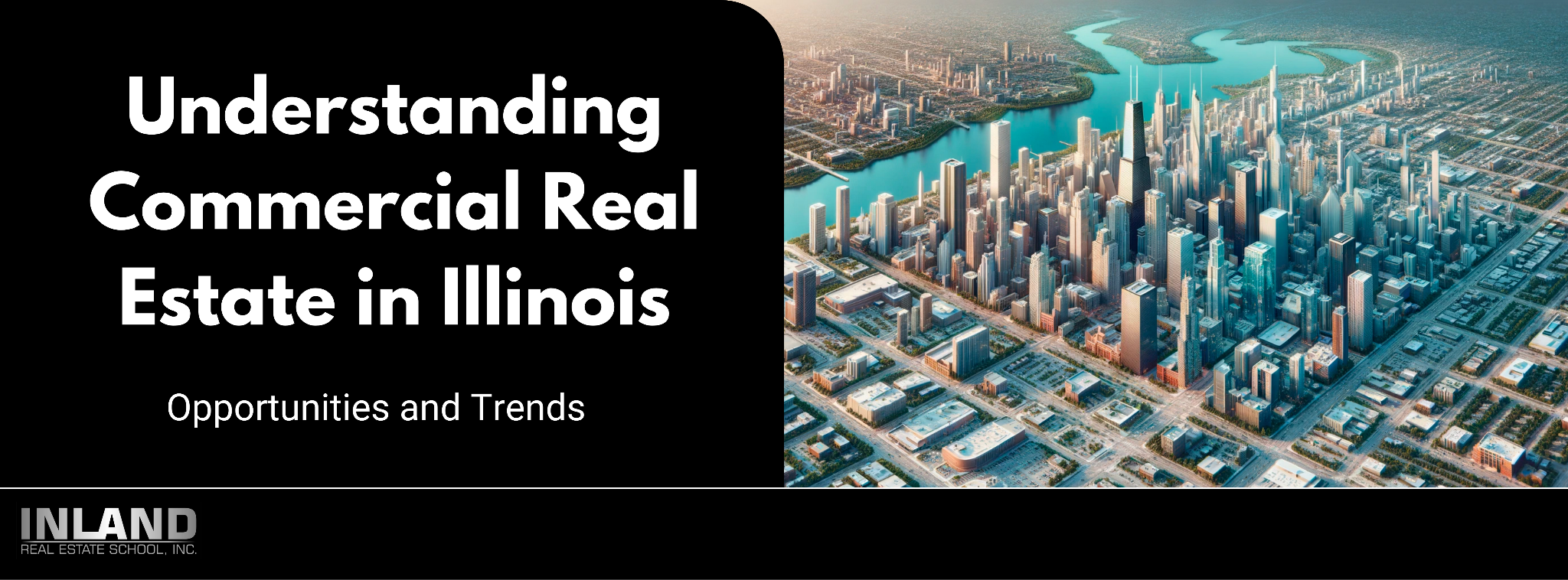
Understanding Commercial Real Estate in Illinois: Opportunities and Trends
Introduction
Overview of the Landscape:
The commercial real estate landscape in Illinois, as we move through 2023, reflects a market at a pivotal point of transformation. Retail sectors are navigating a period of uncertainty, and the trajectory of office spaces remains unclear in the face of evolving workplace dynamics. Adding to this complexity are persistent supply chain disruptions and inflationary pressures, which are near four-decade highs, compelling the Federal Reserve to implement steady interest rate hikes.
Influence of Macroeconomic Factors:
The market is also significantly influenced by macroeconomic forces, including geopolitical issues such as the war in Ukraine and sanctions on Russia, which have rippled globally, affecting everything from food and energy prices to shelter costs. This is compounded by record-high inflation rates, which have not been seen since the 1980s, impacting both affordable and market-rate housing. Additionally, rising interest rates are poised to further affect the real estate sector, potentially altering the dynamics between renting and homeownership.
This introduction sets the stage for a deeper dive into the specific trends, challenges, and opportunities within Illinois' commercial real estate market in 2023. The ensuing sections will explore sector-specific trends, the potential impact of economic forces, and the strategies stakeholders can adopt to navigate this complex landscape.
Current Market Trends
1. Overview of Current Trends
Challenges in the Retail and Office Space: The Illinois commercial real estate market in 2023 faces significant challenges. Retail sectors are at a critical juncture, with the trajectory for the future of office spaces equally uncertain due to changing workplace dynamics. This uncertainty is compounded by ongoing supply chain disruptions and inflation, which are prompting federal interest rate hikes.
Macroeconomic Influences: National and international geopolitical issues, such as the war in Ukraine and sanctions on Russia, have led to global economic repercussions that are also being felt in the U.S. commercial real estate market. These include increased food, shelter, and energy prices. The U.S. has experienced record-high inflation rates, impacting both affordable and market-rate housing. Additionally, rising interest rates are expected to further affect the real estate sector, possibly altering the dynamics between renting and homeownership.
2. Sector-Specific Trends
Multifamily Properties: Currently, multifamily properties are the highest performing asset class within the market. As of the third quarter of 2022, these properties had a five-year low vacancy rate of 4.4%, demonstrating their resilience amidst broader market challenges.
Affordable Housing: There is a noticeable imbalance between the demand for and supply of affordable and workforce housing. This presents an opportunity for commercial real estate to focus on innovative approaches to increase affordable housing availability.
Industrial Properties: The growth of e-commerce has led to an increased demand for warehouses and industrial spaces. The drive to deliver products to consumers more quickly is fueling innovation in this sector, indicating room for further growth.
Retail Property: The performance of retail properties is highly dependent on location and category. For instance, neighborhood shopping centers in well-populated residential areas are continuing to perform well despite broader market challenges.
Office Buildings: The future of office buildings is uncertain, with vacancy rates not returning to pre-pandemic levels. The sector faces a challenge in adapting to new workplace trends and demands.
Opportunities in Commercial Real Estate
Bright Spots in the 2023 Commercial Real Estate Market:
Resilience of Multifamily Properties: Despite broader challenges, multifamily properties continue to thrive as the highest performing asset class in Illinois. With a five-year low vacancy rate of 4.4% as of the third quarter of 2022, these properties have shown resilience. This strength is further bolstered by the ability of multifamily owners and investors to adjust rents to reflect market changes, helping to mitigate cost increases.
Demand for Affordable Housing: The demand for affordable and workforce housing significantly outweighs the current supply, presenting a lucrative area for growth and innovation in the commercial real estate sector. Potential strategies to increase affordable housing include modular construction, adaptive reuse of buildings, development of mixed-income properties, and leveraging historic tax credits.
Growth in Industrial and E-commerce Sectors: The rise of e-commerce has sparked a growing demand for warehouses and industrial spaces. This trend is expected to continue for at least the next decade, driven by innovations in logistics and last-mile distribution, including the use of drones. The industrial sector's performance is dependent on a balanced mix of supply and demand, suggesting that strategic investments in this area could yield significant returns.
Stable Performance of Neighborhood Retail Centers: Despite challenges in the broader retail sector, neighborhood shopping centers in well-populated residential areas continue to perform well. These centers, catering to essential everyday needs such as grocery shopping, prescription pick-ups, and personal care services, show resilience against market fluctuations.
Adapting to Market Changes:
Reimagining Office Spaces: While the future of office buildings is uncertain, with vacancy rates yet to recover to pre-pandemic levels, there is potential for growth in this sector. Office spaces that adapt to the changing needs of the workforce, such as optimized floorplans for collaboration and added amenities like childcare and catering, may attract businesses and employees back to office settings.
Capitalizing on Market Cycles: The cyclical nature of commercial real estate presents opportunities for astute investors. In a challenging economic environment marked by market volatility and high inflation, there may be opportunities to acquire assets at lower costs, particularly for investors with strong balance sheets prepared to capitalize on downturns.
Challenges Facing the Market
1. Economic Uncertainty:
Pandemic-Induced Challenges: The COVID-19 pandemic has introduced significant economic uncertainty, making it difficult for commercial real estate investors to make accurate predictions about future market conditions. While some markets experienced growth during the pandemic, the high inflation and interest rates in its aftermath have created a challenging environment, particularly for short-term investments. However, long-term investments in commercial real estate are likely to remain less affected by this uncertainty.
2. High Interest Rates:
Impact on Borrowing and Investment: The spike in interest rates in the latter half of 2022, as a measure to control inflation, has made borrowing more expensive. This impacts both the ability of tenants to expand and grow, and the capacity of investors to acquire commercial properties that meet their cash flow expectations. Property prices may need to adjust downwards in the short term to attract buyers until interest rates begin to decrease.
3. E-Commerce Versus Brick and Mortar:
Retail Sector Transformation: The growth of e-commerce has posed significant challenges for traditional brick-and-mortar retailers. While some have adapted by modifying their business models to accommodate both online and physical stores, others struggle to compete with the convenience and pricing of online retailers. This shift has led to an increased demand for industrial spaces like last-mile warehouses and distribution centers.
4. Impact of Climate Change:
Environmental Risks and Property Values: Climate change poses new challenges for commercial real estate, with properties in areas prone to environmental risks like flooding or tornadoes potentially losing value. Investors and tenants need to consider these risks in their long-term plans and investment strategies.
5. Demographic Shifts:
Changing Housing and Workforce Dynamics: The aging Boomer population is leading to significant shifts in the demand for various types of real estate. Post-pandemic changes in the job market, such as the rise in remote work and early retirements, are affecting the demand for office and retail spaces. Conversely, this demographic shift is increasing the demand for retirement and assisted living facilities, offering a potential growth area in commercial real estate.
Future Outlook
Predictions and Expert Opinions on the Future of Illinois Commercial Real Estate:
Recession Possibility: There is an increasing likelihood of a recession, which could make 2023 a challenging year for the commercial real estate industry in Illinois. This potential recession, driven by various economic factors, may impact all asset classes and necessitate a long recovery period.
Macroeconomic Impacts: The interplay of national and international geopolitical issues, market volatility, high inflation, and interest rate hikes is steering the U.S. economy into uncharted territory. The war in Ukraine, sanctions on Russia, and supply chain disruptions have notably driven up costs, affecting both the commercial real estate market and housing affordability.
Sector-Specific Outlook:
Multifamily Properties: Expected to maintain their position as the top-performing asset class, multifamily properties could continue to see low vacancy rates and the ability to adjust rents to market changes.
Affordable Housing: The demand for affordable and workforce housing will likely continue to outweigh supply, presenting opportunities for growth and innovation in this sector.
Industrial and E-commerce Growth: The continued expansion of e-commerce is expected to drive demand for warehouses and industrial spaces. Innovations in logistics and distribution, including drone technology, are likely to propel this sector forward for at least the next decade.
Retail Sector Adaptations: Retail properties' performance will largely depend on location and category. While urban retail may face challenges due to changing work dynamics, neighborhood shopping centers are expected to remain resilient.
Office Space Evolution: The office sector faces uncertainty, with vacancy rates not yet returning to pre-pandemic levels. However, properties that adapt to new workplace trends, such as improved amenities and optimized floorplans, could see a resurgence in demand.
Adapting to Market Changes:
Capitalizing on Cyclicality: Recognizing the cyclical nature of commercial real estate, investors with robust balance sheets could find opportunities to expand their portfolios during economic downturns. Preparedness for market fluctuations will be key for successful navigation in the coming years.
Conclusion
Summarizing Key Takeaways for Illinois' Commercial Real Estate in 2023:
Challenges Ahead: The Illinois commercial real estate market in 2023 is poised to encounter significant challenges, including the likelihood of a recession, persistent supply chain issues, and near 40-year high inflation rates. These factors, combined with geopolitical tensions and market volatility, have placed the U.S. economy in a delicate position, with potential impacts on all asset classes in the commercial real estate sector.
Resilience Amidst Uncertainty: Despite these challenges, there are resilient sectors within the market. Multifamily properties continue to perform strongly, with low vacancy rates and the ability to adjust rents in response to market changes. The industrial sector, driven by the rise in e-commerce, is also experiencing a surge in demand for warehouses and distribution spaces.
Adapting to Changing Dynamics: The retail sector's performance is heavily influenced by location and category, with neighborhood shopping centers continuing to show stability. The office sector, however, remains uncertain, with a focus on adapting to new workplace trends and demands.
Opportunities in Market Cycles: The commercial real estate market's cyclical nature presents opportunities for astute investors. Property owners and investors with strong financial foundations may find prospects to expand their portfolios during economic downturns, capitalizing on market fluctuations.
Encouragement for Stakeholders:
Stakeholders in Illinois' commercial real estate market should stay informed and adaptable in the face of these challenges and opportunities. Understanding the market's nuances and responding strategically to its cyclical nature will be crucial in navigating the year ahead successfully.
WE OFFER OVER
25+
PROGRAMS
WE HAVE SERVED
12000+
STUDENTS
VETERAN STAFF
40+ Years
INDUSTRY EXPERIENCE
PROUDLY PROVIDING
23+ Years
OF EDUCATION
INLAND REAL ESTATE SCHOOL, INC. SUPPORTS

Campus Visiting Hours by appointment only:
1st-18th each month AM times, M-F
19th-end of the month PM times, M-F
Visiting hours need to be scheduled in advance
OAK BROOK, ILLINOIS 60523. © INLAND REAL ESTATE SCHOOL, INC. A PROFESSIONAL STUDIES INSTITUTE, INC. COMPANY, 2010. ALL RIGHTS RESERVED.
NOT AFFILIATED WITH THE INLAND REAL ESTATE GROUP OF COMPANIES, INC. THE INLAND NAME IS USED UNDER LICENSE. Privacy Policy







